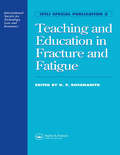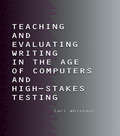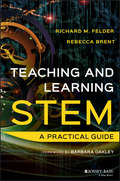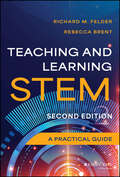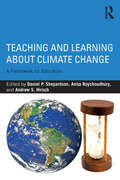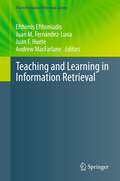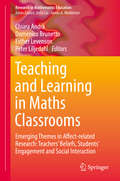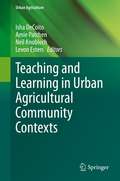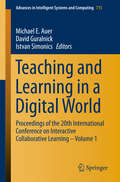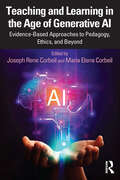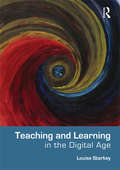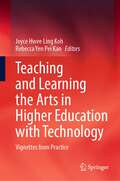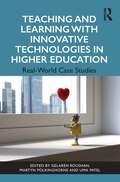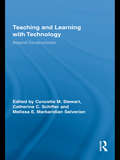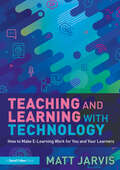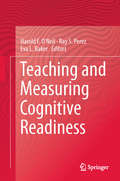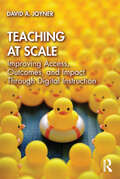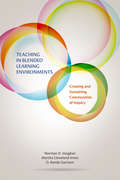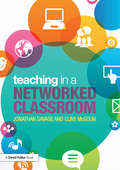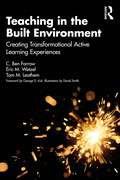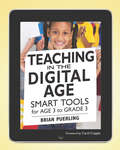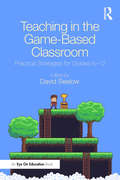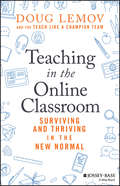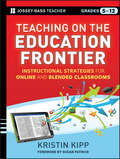- Table View
- List View
Teaching and Education in Fracture and Fatigue
by H. P. RossmanithThis proceedings contains the best contributions to the series of seminars held in Vienna (1992), Miskolc, Hungary (1993 and 1994) and Vienna (1995) and provides a valuable resource for those concerned with the teaching of fracture and fatigue. It presents a wide range of approaches relevant to course and curriculum development. It is aimed particu
Teaching and Evaluating Writing in the Age of Computers and High-Stakes Testing
by Carl WhithausThis book takes on a daunting task: How do writing teachers continue to work toward preparing students for academic and real-world communication situations, while faced with the increasing use of standardized high-stakes testing? Teachers need both the technical ability to deal with this reality and the ideological means to critique the information technologies and assessment methods that are transforming the writing classroom.Teaching and Evaluating Writing in the Age of Computers and High-Stakes Testing serves this dual need by offering a theoretical framework, actual case studies, and practical methods for evaluating student writing. By examining issues in writing assessment--ranging from the development of electronic portfolios to the impact of state-wide, standards-based assessment methods on secondary and post-secondary courses--this book discovers four situated techniques of authentic assessment that are already in use at a number of locales throughout the United States. These techniques stress:*interacting with students as communicators using synchronous and asynchronous environments;*describing the processes and products of student learning rather than enumerating deficits;*situating pedagogy and evaluation within systems that incorporate rather than exclude local variables; and*distributing assessment among diverse audiences.By advocating for a flexible system of communication-based assessment in computer-mediated writing instruction, this book validates teachers' and students' experiences with writing and also acknowledges the real-world weight of the new writing components on the SAT and ACT, as well as on state-mandated standardized writing and proficiency exams.
Teaching and Learning STEM
by Rebecca Brent Richard M. FelderRethink traditional teaching methods to improve student learning and retention in STEM Educational research has repeatedly shown that compared to traditional teacher-centered instruction, certain learner-centered methods lead to improved learning outcomes, greater development of critical high-level skills, and increased retention in science, technology, engineering, and mathematics (STEM) disciplines. Teaching and Learning STEM presents a trove of practical research-based strategies for designing and teaching courses and assessing students' learning. The book draws on the authors' extensive backgrounds and decades of experience in STEM education and faculty development. Its engaging and well-illustrated descriptions will equip you to implement the strategies in your courses and to deal effectively with problems (including student resistance) that might occur in the implementation. The book will help you: Plan and conduct class sessions in which students are actively engaged, no matter how large the class is Make good use of technology in face-to-face, online, and hybrid courses and flipped classrooms Assess how well students are acquiring the knowledge, skills, and conceptual understanding the course is designed to teach Help students develop expert problem-solving skills and skills in communication, creative thinking, critical thinking, high-performance teamwork, and self-directed learning Meet the learning needs of STEM students with a broad diversity of attributes and backgrounds The strategies presented in Teaching and Learning STEM don't require revolutionary time-intensive changes in your teaching, but rather a gradual integration of traditional and new methods. The result will be continual improvement in your teaching and your students' learning.
Teaching and Learning STEM: A Practical Guide
by Rebecca Brent Richard M. FelderThe widely used STEM education book, updated Teaching and Learning STEM: A Practical Guide covers teaching and learning issues unique to teaching in the science, technology, engineering, and math (STEM) disciplines. Secondary and postsecondary instructors in STEM areas need to master specific skills, such as teaching problem-solving, which are not regularly addressed in other teaching and learning books. This book fills the gap, addressing, topics like learning objectives, course design, choosing a text, effective instruction, active learning, teaching with technology, and assessment—all from a STEM perspective. You’ll also gain the knowledge to implement learner-centered instruction, which has been shown to improve learning outcomes across disciplines. For this edition, chapters have been updated to reflect recent cognitive science and empirical educational research findings that inform STEM pedagogy. You’ll also find a new section on actively engaging students in synchronous and asynchronous online courses, and content has been substantially revised to reflect recent developments in instructional technology and online course development and delivery. Plan and deliver lessons that actively engage students—in person or online Assess students’ progress and help ensure retention of all concepts learned Help students develop skills in problem-solving, self-directed learning, critical thinking, teamwork, and communication Meet the learning needs of STEM students with diverse backgrounds and identitiesThe strategies presented in Teaching and Learning STEM don’t require revolutionary time-intensive changes in your teaching, but rather a gradual integration of traditional and new methods. The result will be a marked improvement in your teaching and your students’ learning.
Teaching and Learning about Climate Change: A Framework for Educators
by Daniel P. Shepardson, Anita Roychoudhury and Andrew S. HirschResponding to the issues and challenges of teaching and learning about climate change from a science education-based perspective, this book is designed to serve as an aid for educators as they strive to incorporate the topic into their classes. The unique discussion of these issues is drawn from the perspectives of leading and international scholars in the field. The book is structured around three themes: theoretical, philosophical, and conceptual frameworks for climate change education and research; research on teaching and learning about global warming and climate change; and approaches to professional development and classroom practice.
Teaching and Learning in Information Retrieval
by Andrew Macfarlane Juan F. Huete Juan M. Fernández-Luna Efthimis EfthimiadisInformation Retrieval has become a very active research field in the 21st century. Many from academia and industry present their innovations in the field in a wide variety of conferences and journals. Companies transfer this new knowledge directly to the general public via services such as web search engines in order to improve their information seeking experience. In parallel, teaching IR is turning into an important aspect of IR generally, not only because it is necessary to impart effective search techniques to make the most of the IR tools available, but also because we must provide a good foundation for those students who will become the driving force of future IR technologies. There are very few resources for teaching and learning in IR, the major problem which this book is designed to solve. The objective is to provide ideas and practical experience of teaching and learning IR, for those whose job requires them to teach in one form or another, and where delivering IR courses is a major part of their working lives. In this context of providing a higher profile for teaching and learning as applied to IR, the co-editor of this book, Efthimis Efthimiathis, had maintained a leading role in teaching and learning within the domain of IR for a number of years. This book represents a posthumous example of his efforts in the area, as he passed away in April 2011. This book, his book, is dedicated to his memory.
Teaching and Learning in Maths Classrooms: Emerging Themes in Affect-related Research: Teachers' Beliefs, Students' Engagement and Social Interaction (Research in Mathematics Education)
by Chiara Andrà, Domenico Brunetto, Esther Levenson and Peter LiljedahlThe book presents a selection of the most relevant talks given at the 21st MAVI conference, held at the Politecnico di Milano. The first section is dedicated to classroom practices and beliefs regarding those practices, taking a look at prospective or practicing teachers’ views of different practices such as decision-making, the roles of explanations, problem-solving, patterning, and the use of play. Of major interest to MAVI participants is the relationship between teachers’ professed beliefs and classroom practice, aspects that provide the focus of the second section. Three papers deal with teacher change, which is notoriously difficult, even when the teachers themselves are interested in changing their practice. In turn, the book’s third section centers on the undercurrents of teaching and learning mathematics, which can surface in various situations, causing tensions and inconsistencies. The last section of this book takes a look at emerging themes in affect-related research, with a particular focus on attitudes towards assessment. The book offers a valuable resource for all teachers and researchers working in this area.
Teaching and Learning in Urban Agricultural Community Contexts (Urban Agriculture)
by Amie Patchen Isha DeCoito Neil Knobloch Levon EstersThis book fills a void in the literature around how urban agricultural education can be used to create opportunities to educate youth and citizens who live in urban areas about growing food. To date, very little has been written about program design and the impact of such experiences on learning outcomes. In fact, most of the journal articles and research to date has focused on access, contextual factors, sustainability, relevance of urban agricultural education, and the intersection of science of agriculture. This book will cover such topics as how urban youth learn science while engaged in urban agriculture programs, how such programs support youth in becoming interested about healthy eating and science more generally, and how to design urban agriculture programs in support of STEM education. The chapters in this book are written by educational researchers and each chapter has been reviewed by researchers and practitioners.
Teaching and Learning in a Digital World: Proceedings Of The 20th International Conference On Interactive Collaborative Learning - Volume 1 (Advances In Intelligent Systems And Computing #715)
by Michael E. Auer David Guralnick Istvan SimonicsThis book gathers the Proceedings of the 20th International Conference on Interactive Collaborative Learning (ICL2017), held in Budapest, Hungary on 27-29 September 2017. The authors are currently witnessing a significant transformation in the development of education. The impact of globalisation on all areas of human life, the exponential acceleration of technological developments and global markets, and the need for flexibility and agility are essential and challenging elements of this process that have to be tackled in general, but especially in engineering education. To face these current real-world challenges, higher education has to find innovative ways to quickly respond to them. Since its inception in 1998, this conference has been devoted to new approaches in learning with a focus on collaborative learning. Today the ICL conferences offer a forum for exchange concerning relevant trends and research results, and for sharing practical experience gained while developing and testing elements of new technologies and pedagogies in the learning context.
Teaching and Learning in the Age of Generative AI: Evidence-Based Approaches to Pedagogy, Ethics, and Beyond
by Joseph Rene Corbeil Maria Elena CorbeilTeaching and Learning in the Age of Generative AI explores how educators can effectively harness the potential of artificial intelligence technologies while skillfully navigating its pedagogical, technical, ethical, institutional, and societal implications. The increasing accessibility of AI technologies among K-12 and higher education students has raised extensive concerns around academic integrity, though a deeper lineage of research and development suggests that these tools may be used to supplement instruction, prioritize critical thinking, and promote digital literacy. Bookended by in-depth analyses of the historical and future trajectories of artificial intelligence in education, this comprehensive resource provides evidence-based strategies for classroom implementation and helpful summaries of common benefits and risks. Teaching assistance, personalized learning, redefined assessments, anti-bias measures, and safeguards against misconduct and privacy infringement are among the wealth of topics addressed in these chapters. This book is an ideal text for undergraduate and graduate students of teacher education and curriculum and instruction as well as for higher education teaching faculty, school technology coordinators, and talent development personnel in training and in service.
Teaching and Learning in the Digital Age
by Louise StarkeyTeaching and Learning in the Digital Age is for all those interested in considering the impact of emerging digital technologies on teaching and learning. It explores the concept of a digital age and perspectives of knowledge, pedagogy and practice within a digital context. By examining teaching with digital technologies through new learning theories cognisant of the digital age, it aims to both advance thinking and offer strategies for teaching technology-savvy students that will enable meaningful learning experiences. Illustrated throughout with case studies from across the subjects and the age range, key issues considered include: how young people create and share knowledge both in and beyond the classroom and how current and new pedagogies can support this level of achievement the use of complexity theory as a framework to explore teaching in the digital age the way learning occurs – one way exchanges, online and face-to-face interactions, learning within a framework of constructivism, and in communities what we mean by critical thinking, why it is important in a digital age, and how this can occur in the context of learning how students can create knowledge through a variety of teaching and learning activities, and how the knowledge being created can be shared, critiqued and evaluated. With an emphasis throughout on what it means for practice, this book aims to improve understanding of how learning theories currently work and can evolve in the future to promote truly effective learning in the digital age. It is essential reading for all teachers, student teachers, school leaders, those engaged in Masters’ Level work, as well as students on Education Studies courses.
Teaching and Learning the Arts in Higher Education with Technology: Vignettes from Practice
by Joyce Hwee Ling Koh Rebecca Yen Pei KanThis book is an inquiry about the possibilities of using technology to support the education of artists within higher education contexts. Even though technology-enhanced learning and teaching may seem incongruent with the long-established studio-based cultures of making and performing, it is increasingly becoming a pivotal point to connect artistes to potential audience and markets. Amidst the COVID-19 pandemic, technology is also the crucial linchpin for educational continuity of student artists. This book explores how technology could enhance the education of artists and designers as they continue to create, make, and add value to life and society through their artistry. It draws upon the experiences of the Nanyang Academy of Fine Arts (NAFA), a pioneering arts institution in Singapore with over 80 years of institutional history. Through 9 vignettes, this book illustrates technology-enhanced pedagogical practices that have been implemented in different artistic learning spaces including classroom, studio, and stage as well as institutional support strategies. With a naturalistic stance, these chapters seek to illuminate realistic pictures of teaching and learning that are being uncovered by artist educators as they sought to integrate technology within teaching practices using available technologies and within the classes that they are teaching. It is hoped that this book will stimulate conversation among artist educators about possible pedagogical models, as well as inform higher arts institutions about the contextual strategies needed to support the creation of technology-enhanced pedagogical practices.
Teaching and Learning with Innovative Technologies in Higher Education: Real-World Case Studies
by Gelareh Roushan Martyn Polkinghorne Uma PatelTeaching and Learning with Innovative Technologies in Higher Education provides a wealth of expertly curated case studies demonstrating how educators and technologists can leverage emerging digital technologies to enhance students’ experiences. As university staff integrate transformative digital learning tools into their pedagogical practices with a mix of excitement and consternation, new insights are needed into the opportunities, success and limitations of these fast-evolving tools. This book presents real-world examples of effective, digitally enriched approaches to teaching delivery and standards, student engagement and inclusivity, immersive simulations and environments and beyond. Spanning a diverse, comprehensive range of digital technologies deployed in higher education, these practical case studies will guide novice and experienced academics across disciplines in updating their instructional skills and course content for new generations of learners.
Teaching and Learning with Technology: Beyond Constructivism (Routledge Research in Education #Vol. 37)
by Concetta M. StewartToday, new media is both augmenting and extending the traditional classroom with a variety of technology-based tools available to both students and faculty, and has created "new" virtual classrooms for anywhere, anytime availability to education. Despite the enormous potential for technology to support the educational enterprise in this emerging "creative" economy, technologies are still not yet fully integrated in the classroom and their association with educational outcomes is as-yet unclear. This book profiles scholarly work from around the world to examine closely the effectiveness of the newest media in education at bridging the gaps among and between teachers, students and subject matter at all levels, from K-12 through adult education. These pieces are theory-based investigations with implications for future research, theory and application. Contributors examine how the fields of education and new media have evolved and are continuing to evolve pedagogically and practically, from predominantly instructivist, with a passive, one-way teaching format; to constructivist, including teacher- and learner-controlled, sensorially immersive and socially interactive exchanges. This book will be of interest to students and faculty in the areas of new media in education, including distance learning, online learning and "virtual" learning.
Teaching and Learning with Technology: How to Make E-Learning Work for You and Your Learners
by Matt JarvisTeaching and Learning with Technology sets out key principles for digital learning underpinned by research evidence. It explores the ways in which technology can help teachers to achieve their goals and support good pedagogy and offers practical strategies for using technology when planning and delivering effective lessons. Drawing on examples from across the curriculum and highlighting a wide range of key technologies, chapters cover: Live remote teaching Delivering content and instruction Using technology to assess learning Alternative learning platforms Ensuring accessibility and personalising learning E-safety, safeguarding and legal compliance Written by a leading expert in digital education and filled with easy-to-implement tips, this book is an essential guide for all teachers delivering lessons online.
Teaching and Measuring Cognitive Readiness
by Eva L Baker Ray S. Perez Harold F. O'NeilTeaching and Measuring Cognitive Readiness presents theoretical and empirical findings regarding cognitive readiness and assessments of their impact on adult learning. The term readiness is used in assessing student preparation for K-12 schools, while in the military and in industry, "readiness" denotes preparation to be effective in performing a mission or a job. Cognitive Readiness is viewed through a Knowledge, Skills, and Attributes (KSA) lens. Teaching and Measuring Cognitive Readiness deals with (a) the primacy of cognitive readiness as attributes or individual difference variables; (b) the need for cognitive readiness instructional and assessment strategies; (c) the need to integrate assessment into cognitive readiness training; (d) the need for theory-driven evaluation studies to increase knowledge and efficacy in teaching cognitive readiness; and (e) the need for a solid psychometric approach to the use of cognitive readiness assessments.
Teaching at Scale: Improving Access, Outcomes, and Impact Through Digital Instruction
by David A. JoynerTeaching at Scale explores the characteristics and parameters of large-scale online learning by identifying, in its perceived drawbacks, a wealth of educational opportunities in disguise. Scalable learning platforms have exploded in popularity over recent years, with MOOCS (massive open online courses), online degree programs, informal learning communities, and alternative credentials all drawing significant enrollments. But, as many educators are asking, are the challenges to delivering education at scale too great and the compromises too many? This book guides instructors to leverage their complex responsibilities—open-ended assessments at scale, individuated feedback to students, academic integrity in less controlled environments, and more—into significant assets. Informed by real-world institutional experience as well as key research in cognitive science and the learning sciences, each chapter provides practical strategies for educators and administrators seeking to solve problems and fulfill the high-quality, broad-access potential of large-scale instruction for lifelong learners.
Teaching at Scale: Improving Access, Outcomes, and Impact Through Digital Instruction
by David JoynerTeaching at Scale explores the characteristics and parameters of large-scale online learning by identifying, in its perceived drawbacks, a wealth of educational opportunities in disguise. Scalable learning platforms have exploded in popularity over recent years, with MOOCS (massive open online courses), online degree programs, informal learning communities, and alternative credentials all drawing significant enrollments. But, as many educators are asking, are the challenges to delivering education at scale too great and the compromises too many? This book guides instructors to leverage their complex responsibilities—open-ended assessments at scale, individuated feedback to students, academic integrity in less controlled environments, and more—into significant assets. Informed by real-world institutional experience as well as key research in cognitive science and the learning sciences, each chapter provides practical strategies for educators and administrators seeking to solve problems and fulfill the high-quality, broad-access potential of large-scale instruction for lifelong learners.
Teaching in Blended Learning Environments: Creating and Sustaining Communities of Inquiry
by D. Randy Garrison Norman D. Vaughan Martha Cleveland-InnesTeaching in Blended Leaning Environments provides a coherent framework in which to explore the transformative concept of blended learning. Blended learning can be defined as the organic integration of thoughtfully selected and complementary face-to-face and online approaches and technologies. A direct result of the transformative innovation of virtual communication and online learning communities, blended learning environments have created new ways for teachers and students to engage, interact, and collaborate. The authors argue that this new learning environment necessitates significant role adjustments for instructors and generates a need to understand the aspects of teaching presence required of deep and meaningful learning outcomes. Built upon the theoretical framework of the Community of Inquiry – the premise that higher education is both a collaborative and individually constructivist learning experience – the authors present seven principles that provide a valuable set of tools for harnessing the opportunities for teaching and learning available through technology. Focusing on teaching practices related to the design, facilitation, direction and assessment of blended learning experiences, Teaching in Blended Learning Environments addresses the growing demand for improved teaching in higher education.
Teaching in a Networked Classroom
by Jonathan Savage Clive McGounThe pace of technological change has made the immediate and long-term future difficult, if not impossible, to predict. Teachers are forced to imagine the world they are preparing their students to live in. In this situation creativity becomes a vital resource for enabling uncertain futures to be embraced and an important attribute for students to have both for their learning and their employability in the future. In this book, the authors argue that creativity is a social and collaborative process that can be enhanced through online and digital technologies. Filled with case studies and practical tasks, it shows teachers how they can develop an approach to teaching and learning with digital technologies that is inherently social, collaborative and creative. Including case studies and practical examples of projects and lessons throughout, the chapters cover: Learning in a networked society An examination of sharing practices and how knowledge can be shared more effectively Potential pitfalls of virtual learning environments and public social networking sites Using digital media to plan schemes of work and lessons How to facilitate meaningful collaboration and discussion through digital media Creating online environments to enable students to share their understandings and learning Bringing together key ideas about creativity, collaborative learning and ICT in the classroom, this timely book will be an invaluable resource for all teachers.
Teaching in the Built Environment: Creating Transformational Active Learning Experiences
by C. Ben Farrow Eric Wetzel Thomas LeathemTeaching in the Built Environment: Creating Transformational Active Learning Experiences offers a blueprint for teaching success from an award-winning team of educators, with classroom-ready strategies for maximizing undergraduate learning in built environment disciplines. Drawing on the authors’ years of experience as education researchers and faculty at one of the nation’s top design and construction schools, this primer empowers instructors to implement high impact teaching practices in any educational setting, from intimate seminars to "mega classes" of hundreds of students. Chapters on internships, study abroad, and field experiences equip faculty with teaching tools guaranteed to work on or off campus. Just as importantly, this book identifies the teaching tactics that don’t work. The authors’ candid reflections on their own failed pedagogical experiments help instructors avoid confidence-shaking missteps and encourage them to turn teaching struggles into future successes. A thorough review of the latest education research provides theoretical context and empirical support for strategies direct from the authors’ award-winning classrooms, studios, and labs. Features: Classroom-tested strategies for maximizing undergraduates’ learning in built environment disciplines Adapted teaching methods from the authors’ award-winning classrooms, studios, and labs to any higher education setting An ideal resource for built environment faculty, from first timers to veteran educators The latest research on teaching and learning in design and construction disciplines A must-read for built environment educators, from first-time faculty to classroom veterans, Teaching in the Built Environment: Creating Transformational Active Learning Experiences inspires teaching that will resonate long past the semester’s end.
Teaching in the Digital Age
by Carol Copple Brian PuerlingTechnology is rapidly changing the ways we live our lives and interact with the world. It's also changing how you teach. Technology can enhance your classroom's complete curriculum and assessment and help you create and capture meaningful experiences, support inquiry, and expand your classroom's walls. This comprehensive framework will help you select and use a variety of technology and interactive media tools in your classroom-including digital cameras, audio recorders, webcams, publication and presentation tools, and multi-touch mobile devices.Reflecting Technology in Early Childhood Programs, the joint position statement of the National Association for the Education of Young Children and the Fred Rogers Center, Teaching in the Digital Age: Smart Tools for Age 3 to Grade 3 includesDevelopmentally appropriate and effective strategies to use technology to facilitate children's learning28 links to video clips that provide a deeper look at how these practices are used in real classrooms32 forms to help you plan, reflect on, and evaluate how you use technology to help children learnBrian Puerling, a National Board Certified Teacher and graduate of the Erikson Institute, is the Director of Education Technology at the Catherine Cook School in Chicago. He is a former preschool teacher, a member of the National Association for the Education of Young Children's Tech and Young Children Interest Forum, serves on the Sesame Workshop Teacher Council, is active with the Chicago Metro Association for the Education of Young Children, and is a popular presenter at national conferences.
Teaching in the Game-Based Classroom: Practical Strategies for Grades 6-12
by David SeelowTeaching in the Game-Based Classroom is a hands-on guide to leveraging students’ embrace of video games toward successful school performance. Evidence tells us that game-based learning can help teachers design classes, develop transformative learning tools, and assess progress on multiple levels not dependent on one-size-fits-all bubble sheets. Authored by game-savvy teachers in partnership with classroom-experienced academics, the highly varied chapters of this book are concise yet filled with sound pedagogical approaches. Middle and high school educators will find engaging new ways of inspiring students’ intrinsic motivation, skill refinement, positive culture-building, autonomy as learners, and more.
Teaching in the Online Classroom: Surviving and Thriving in the New Normal
by Doug LemovA timely guide to online teaching strategies from bestselling author Doug Lemov and the Teach Like a Champion team School closures in response to the covid-19 coronavirus pandemic resulted in an immediate and universal pivot to online teaching. More than 3.7 million teachers in the U.S. were suddenly asked to teach in an entirely new setting with little preparation and no advance notice. This has caused an unprecedented threat to children's education, giving rise to an urgent need for resources and guidance. The New Normal is a just-in-time response to educators’ call for help. Teaching expert Doug Lemov and his colleagues spent weeks studying videos of online teaching and they now provide educators in the midst of this transition with a clear guide to engaging and educating their students online. Although the transition to online education is happening more abruptly than anyone anticipated, technology-supported teaching may be here to stay. This guide explores the challenges involved in online teaching and guides educators and administrators to identify and understand best practices. It is a valuable tool to help you and your students succeed in synchronous and asynchronous settings this school year and beyond. Learn strategies for engaging students more fully online Find new techniques to assess student progress from afar Discover tools for building online classroom culture, combating online distractions, and more Watch videos of teachers building rigor and relationships during online instruction The New Normal features real-world examples you can apply and adapt right away in your own online classroom to allow you to survive and thrive online.
Teaching on the Education Frontier: Instructional Strategies for Online and Blended Classrooms Grades 5-12
by Kristin KippA groundbreaking guide to facilitating online and blended courses This comprehensive resource offers teachers in grades K-12 a hands-on guide to the rapidly growing field of online and blended teaching. With clear examples and explanations, Kristin Kipp shows how to structure online and blended courses for student engagement, build relationships with online students, facilitate discussion boards, collaborate online, design online assessments, and much more. Shows how to create a successful online or blended classroom Illustrates the essential differences between face-to-face instruction and online teaching Foreword by Susan Patrick of the International Association for K-12 Online Learning This is an essential handbook for learning how to teach online and improve student achievement.
